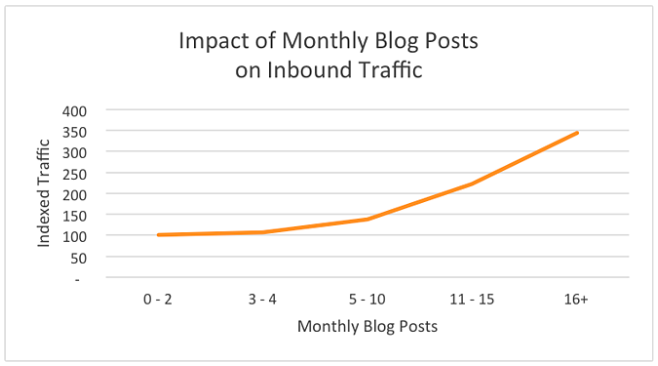Why It Is Important to Blog Regularly
Blogging helps gain traffic incrementally, that’s why posting regularly can help support this growth. Following a schedule has some obvious advantages that may help achieve different goals.
First, it allows you to retain your audience who knows when to expect new content.
Second, it helps plan your posting and distribute workload evenly during the month not to overdo it and burn out.
Third, following a schedule gives you space and time to update old content (we will also talk about it later).
How to Find Ideal Frequency
An ideal frequency is a vast thing that builds upon your business characteristics. For example, smaller companies often post a couple of times per week, while bigger businesses deliver content on a daily basis. When deciding how often to post blog content, you need to take into account what is best for your company and what objectives you want to achieve.
Goals
Realizing your motivation makes it easier to figure out how often you should publish a blog post. So the first step is to identify objectives that you want to achieve with blogging. For example,
- Attract organic traffic to your website
- Build brand awareness
- Establish yourself as an authority
- Boost one of marketing channels with content
And then choose a posting frequency that serves your objectives best. For instance, if you strive to increase organic traffic to your website, it’s very important to post more often, as far as the resources permit. Then, you may also need places to look for content writers to guarantee your content is up to your audience’s expectations and to have some extra hands.
Another common objective is building brand awareness. It’s vital to diversify your content rather than just post frequently. Think of all kinds of materials that can help present yourself as an expert, such as branded infographics, and make sure the content you share is high quality.
Hubspot recommends the following posting depending on the blogging goal.

Channels
Posting frequency also depends on the marketing channels you deploy, because they have different audiences and, consequently, expectations. For example, it’s vital to post frequently if you target social media. Generally, a lifespan of a blog post on social networks (such as Facebook, Twitter, or Instagram) is no longer than one day. This means that your social blogging requires daily updates to keep you afloat.
On the other hand, to drive search traffic, you don’t need to post that often. Ranking high doesn’t happen overnight, it’s rather an incremental process, so a few blog posts per week would suffice.
Demand
An efficient content marketing strategy always builds upon the audience and their needs and pain points. That is why your main task is to determine what your readers are looking for and ensure your blog content lives up to their expectations.
Try to diversify your blog materials and see what kind of posts work best for your audience. It can be promo posts, infographics, video tutorials, pieces of news, long reads, and so on. This will also be helpful if you wonder, “How long should my blog post be?” Try out different options and find an optimal solution.
Time and Workforce
When you’ve identified how many blog posts per week you need, align it with available time and workforce resources. It’s very important to spread the workload evenly during the month and take care of everything.
If you work in a team of one, consider writing a couple of long reads per month that present an in-depth consideration of the matter, help build authority and are SEO-friendly. Dedicate the remaining time to writing pieces of news and short posts, highlighting product benefits and the like. If you have more people on board, commit to posting on blog once a week, preferably, long reads, and publishing several smaller posts in between to show Google you’re active.
It’s vital not only to have enough manpower to write posts, but also to convert leads. If you work on your own, allocate time to building a mailing list, send newsletters and keep in touch with subscribers by other means. If possible, assign this task to a particular employee who’ll take care of all leads.
Best Practices for Regular Blogging
Strategically frequent blogging has its benefits for your website rating and your brand promotion. We have collected some tips on how to make your blogging practice regular, but not at the cost of quality.
The More Posts, the More Traffic
The rule of thumb is the more you post, the more traffic you gain. But, it is a long-term process that will take a year or more before you can assess the performance.
Are there any milestones to aim for? According to a study, to see a noticeable difference in blog traffic, you need to publish 11 to 15 posts a month, as you can see on the graph below.

Another research showed that you need to post 55 to 70 articles as soon as possible to start gaining significant traffic. Such an amount allows Google to look at your site favorably and rank it higher.
Finally, there is some evidence suggesting that blogs that publish content every week are two and a half times more likely to see an increase in traffic compared to the competition.
Don’t Drive Traffic at the Cost of Engagement
As tempting as it is to choose quantity over quality, such content won’t make visitors stay long on your site, resulting in low engagement levels. For example, you’ll have thousands of views but only few shares, likes and comments.
Why exactly is it bad practice? You could gain huge traffic but such leads will be hard to convert into customers. Their low engagement and high bounce rate will show Google that the post doesn’t really bring value and isn’t worth ranking high.
Experts from the Moz team say higher frequency is a delusion if you don’t consider other important factors such as your post value for users, features of your niche, aligning goals with the schedule, being consistent and so on.
Choose the Best Posting Time
Choosing the best time to publish a blog post is just as important as establishing frequency. Such timing will greatly depend on your audience and its geolocation as well as the channels you deploy for promotion.
For example, when choosing the best time to send a newsletter, consider time windows when subscribers are likely to open their mailbox, such as 10 a.m., 2 p.m., and 8 p.m. What day of the week is best to post a blog update? Again, follow expert advice and reach out Monday to Wednesday, as these are the days with highest open rates.
To find the right posting time on social media, try to think of the moments when your audience will be online and looking for distraction or communicating with friends. It can be lunch time, coffee breaks, commutes to and from work (morning and evening), and so on.
Update or Repurpose Old Content
Apart from writing new articles, take time to update the existing content. First, it will ensure that the site always has only relevant and the freshest data. Second, updates drive more traffic and show search engines that you are active. For example, Hubspot dedicates plenty of time to updating old articles, as they generate 70% of the blog traffic.
What’s good, updating articles can help in SEO. Learn how to determine which blog posts need to be updated and how to optimize your blog content. Watch the recording of our webinar with Laura Peters, entitled “SEO Tutorial for Travel Bloggers: Get More Traffic From Old Blog Posts”, or its recap.
Likewise, you can also find the most popular content and share it again, on social media or in other channels. The key is to find a reasonable balance between producing new content and updating an old one.
How Often to Post Blog Content
Your website’s traffic and engagement level are hugely impacted by your posting frequency. Yet, quality and uniqueness come first and a thoroughly prepared posting schedule can help successfully promote your blog and attract new audiences. It can also help you outpace the competition, if you manage to post more frequently than they do. Thus, the right schedule can greatly help reach many objectives and naturally grow your business.




